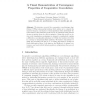Free Online Productivity Tools
i2Speak
i2Symbol
i2OCR
iTex2Img
iWeb2Print
iWeb2Shot
i2Type
iPdf2Split
iPdf2Merge
i2Bopomofo
i2Arabic
i2Style
i2Image
i2PDF
iLatex2Rtf
Sci2ools
PPSN
2004
Springer
2004
Springer
A Visual Demonstration of Convergence Properties of Cooperative Coevolution
Abstract. We introduce a model for cooperative coevolutionary algorithms (CCEAs) using partial mixing, which allows us to compute the expected long-run convergence of such algorithms when individuals’ fitness is based on the maximum payoff of some N evaluations with partners chosen at random from the other population. Using this model, we devise novel visualization mechanisms to attempt to qualitatively explain a difficult-to-conceptualize pathology in CCEAs: the tendency for them to converge to suboptimal Nash equilibria. We further demonstrate visually how increasing the size of N, or biasing the fitness to include an ideal-collaboration factor, both improve the likelihood of optimal convergence, and under which initial population configurations they are not much help.
Cooperative Coevolutionary Algorithms | Distributed And Parallel Computing | Long-run Convergence | PPSN 2004 | Suboptimal Nash Equilibria |
Related Content
| Added | 02 Jul 2010 |
| Updated | 02 Jul 2010 |
| Type | Conference |
| Year | 2004 |
| Where | PPSN |
| Authors | Liviu Panait, R. Paul Wiegand, Sean Luke |
Comments (0)

